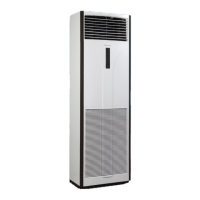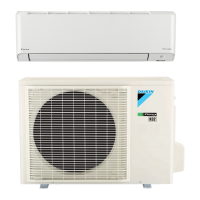16■English
Refrigerant Piping Work
Refer also to the installation manual for the outdoor unit.
WARNING
• Do not apply mineral oil on ared part.
• Prevent mineral oil from getting into the system as this would reduce the service life of the units.
• Never use piping which has been used for previous installations. Only use parts which are delivered with the unit.
• Never install a dryer to this R410A unit in order to guarantee its service life.
• The drying material may dissolve and damage the system.
• Incomplete aring may result in refrigerant gas leakage.
Execute thermal insulation work completely on both sides of the gas and the liquid piping. Otherwise, a water leakage can
result sometimes.
For gas piping, use insulation material of which heat resistant temperature is not less than 230°F (110°C).
Also, in cases where the temperature and humidity of the refrigerant piping sections might exceed 86°F (30°C) or RH80%,
reinforce the refrigerant insulation. (13/16 inch (20mm) or thicker) Condensation may form on the surface of the insulating
material.
Before refrigerant piping work, check which type of refrigerant is used. Proper operation is not possible if the types of
refrigerant are not the same.
1. Flaring the pipe end
1) Cut the pipe end with a pipe cutter.
2) Remove burrs with the cut surface facing downward,
so that the lings do not enter the pipe.
Cut exactly at
right angles.
Remove burrs.
3) Put the are nut on the pipe.
4) Flare the pipe.
5) Check that the aring has been done correctly.
A
A
Flaring
Set exactly at the position shown below.
Die
0-0.020 inch
(0-0.5mm)
Clutch-type
Flare tool for
R32 or R410A
0.039-0.059 inch
(1.0-1.5mm)
Clutch-type
(Rigid-type)
0.059-0.079 inch
(1.5-2.0mm)
Wing-nut type
(Imperial-type)
Conventional flare tool
The flare’s inner surface must be
flaw-free.
When flaring, do not over-tighten
and crack.
The pipe end must be evenly flared
in a perfect circle.
Make sure that the flare nut is fitted.
Check
2. Refrigerant piping
CAUTION
• Use the are nut xed to the main unit. (This is to prevent the are nut from cracking as a result of deterioration over time.)
• To prevent gas leakage, apply refrigeration oil only to the inner surface of the are. (Use refrigeration oil for R410A.)
• Use a torque wrench when tightening the are nuts to prevent damage to the are nuts and gas leakage.
• Do not have oil adhere to the screw xing part of resin parts.
If oil adheres, it may weaken the strength of screwed part.
• Align the centers of both ares and tighten the are nuts 3 or 4 turns by hand, then tighten them fully with a spanner and
a torque wrench.
Do not apply refrigeration
oil to the outer surface.
Flare nut
Apply refrigeration
oil only to the inner
surface of the flare.
Do not apply refrigeration oil to
the flare nut to avoid tightening
with excessive torque.
Apply oil
Torque wrench
Piping union
Flare nut
Spanner
Tighten
Piping size Flare nut tightening torque
Gas side
O.D. 3/8 inch (9.5mm) 24-1/8–29-1/2Ibf • ft (32.7-39.9N • m)
O.D. 1/2 inch (12.7mm) 36-1/2–44-1/2Ibf • ft (49.5-60.3N • m)
O.D. 5/8 inch (15.9mm) 45.6–55.6lbf • ft (61.8-75.4N • m)
Liquid side O.D. 1/4 inch (6.4mm) 10-1/2–12-3/4Ibf • ft (14.2-17.2N • m)
English
01_EN_3P674701-1B.indd 16 2022/06/02 10:06:28

